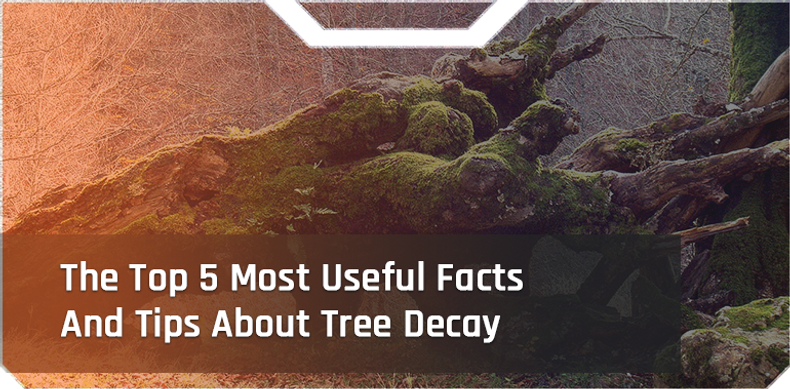Decay is sometimes referred to as a tree’s most dangerous hidden defect. It can be pretty hard to spot from an untrained eye, or even sometimes from someone who knows a bit about trees.
Unfortunately the stealth nature of Tree Decay does not make it any less dangerous. Severe decay, in fact, will usually lead to the death of a tree. With risk management, you may be able to avoid removing a tree but it sadly will never be cured.
Although this is a sort of grim subject matter, we are going to try to keep things a little light hearted with some necessary humor and optimism. With that disclaimer, let’s get started.
Related Article:
A Guide To When A Tree Needs Care
1. Signs Of Decay: Who Among Us Has The Fungus?
Should you be trippin’ on those shrooms?
The answer is yes, but not in the way you think. By tripping on shrooms, we mean you should be worrying about mushrooms growing on a tree. Where there are mushrooms growing out of a tree or its roots, there is decay.
This should be of concern.
Tree Decay causes limbs to drop, the inside of trees can lose their functions, soil can get depleted, and ultimately it can cause brittleness in a tree’s wood that will deplete its bending strength.
Some Signs Of Tree Decay:
- Ants
- Bees
- Cracks
- Bulges
- Cavities
- Sponginess
- Oozing Bark
- Tree Leaning
- Root Damage
- Cracks In The Bark
- Cavity Nesting Birds
- Mushrooms & Other Fungus
- Discoloration In Tree Bark, Especially A White Tint
- Atypical Leaf Patterns (Leaves Dying, Leaves Not Falling In Winter)
Some trees are especially susceptible to decay, with Silver Maples being one of the most noted examples. Decay will change the ways that sugars are distributed in a tree and it often occurs, starting from the inside to the outside of the tree. This is one of the main barriers to early detection.
2. A Fun Guy’s Guide To Fungi
Look, I’m a fun guy. I like music, friends, joking around, amusement parks, and the occasional tastefully made rom-com. However when it comes to fungus, I don’t play.
There are a few things that are useful to know about different kinds of fungus.
Different Forms Of Fungal Decay:
- Soft Rot
- White Rot
- Brown Rot
Brown Rot is the most concerning as it usually has the fastest impact on a tree. It is most common in pine trees, fir trees, and spruce trees. Brown Rot is quick to damage the bending strength of a tree by making it brittle.
White Rot is much less concerning. When White Rot Decay is less severe, initially a tree will sometimes develop its own defenses, growing new wood around an infected area. White Rot is most common in flowering trees.
Soft Rot shares characteristics with both White Rot and Brown Rot. Thankfully, it is not found in living trees.
3. How To Delay The Decay
As stated earlier, there is no cure for Tree Decay. Rather than eliminating Tree Decay, treatment is about minimizing and delaying the impacts of decay. This falls under risk management rather than risk elimination.
Unfortunately, sometimes decay means that a tree is going to die very soon or that it will drop large limbs. If these types of risks are deemed to be serious enough, a tree will likely need to be completely removed, rather than treated.
Some Risk Management Strategies For Delaying Or Minimizing Tree Decay:
- Pruning Infected Branches
- Removing Large Infected Stems
- Installing Tree Support Systems
4. Why Do You Fill Me Up, Buttercup?
Not super long ago, filling cavities of infected trees was common practice. The idea was that using foam or other fillers would protect the tree from excessive moisture and pests.
Unfortunately that strategy doesn’t work.
In fact, it will hurt trees more than helping them and here's why...
Damages That Cavity Fillers Will Cause To A Tree:
- Absorbing Moisture
- Preventing New Growth
- Preventing Trees From Developing Defenses
5. Who You Gonna Call?
If you suspect that a tree is suffering from decay, you should call a skilled Arborist. These Tree Specialists can assess whether decay is present, how severe decay may be, and ideally some form of treatment. If a tree can not be treated, Arborists are usually the best suited people to remove a tree.
Ways That An Arborist Tree Worker May Assess A Tree For Decay:
- Probing A Cavity
- Root Collar Excavations
- Resistance Recording Devices
- Acoustic Measurement Devices
When possible, using an Increment Borer should be avoided as it always requires damage to the bark of a tree and can sometimes excel decay.
There’s Not Mush Room For More Discussion
We fulfilled our promise to give you 5 useful facts and tips about Tree Decay and sadly we must now let you go.
If you are dealing with the realization that your favorite tree may be suffering from decay, we wish you the best of luck in helping him out. With guidance from a tree specialist, you will be able to make the best decision for the tree, your home, and your neighbors.





